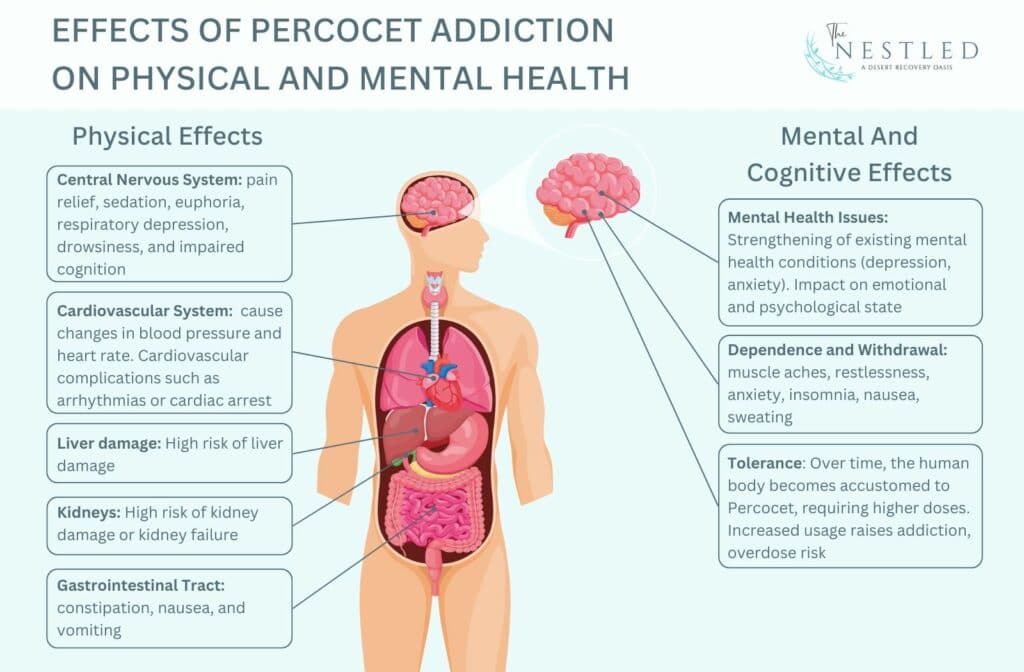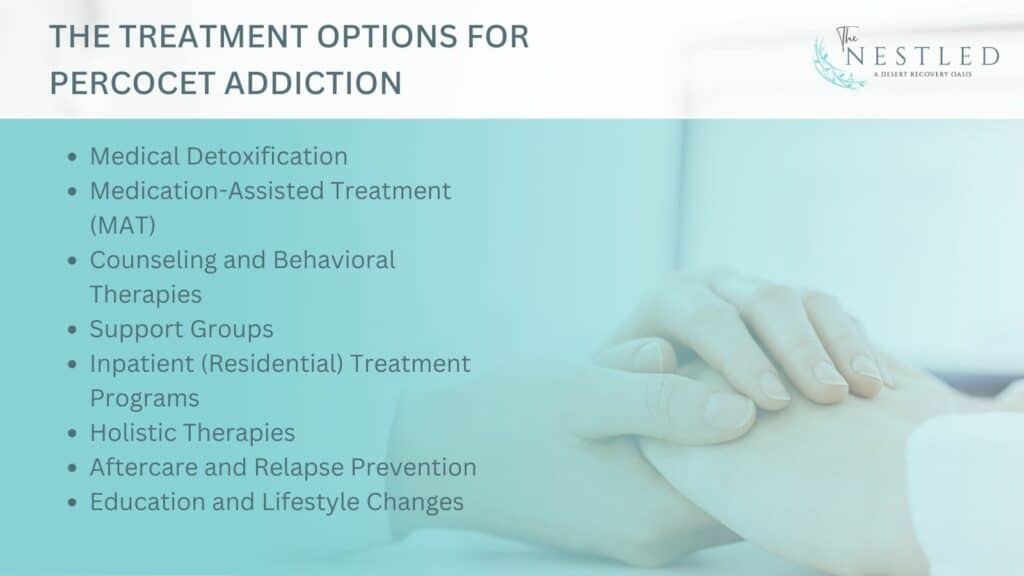Percocet addiction is a disorder in which an individual engages in the compulsive and excessive consumption of Percocet despite facing harmful consequences to one’s health, social life, and overall well-being. Percocet is a prescription medication, but when abused, it becomes addicting. According to the United States Department of Justice, more than 13 million Americans abuse Oxycodone, including some children as young as 12 years old.
Signs of Percocet addiction include increased tolerance to the drug and withdrawal symptoms, such as restlessness, irritability, and physical discomfort. People addicted to Percocet often fail at trying to control or reduce use.
Percocet addiction is caused by regular use of the drug, which leads to dependence. Genetic predispositions and psychological factors, such as stress, anxiety, or underlying mental health disorders, also contribute to Percocet addiction.
Percocet addiction leads to physical harm, such as liver damage from the acetate in Percocet, and mental health issues like depression or anxiety. It also causes problems in personal and professional relationships.
Treatment for Percocet addiction often includes a combination of medication-assisted therapy, counseling, and support groups to address both physical dependence and psychological issues.
What Is Percocet Addiction?
Percocet addiction is a type of substance use disorder that occurs when an individual becomes physically and psychologically dependent on Percocet. This prescription painkiller contains a combination of oxycodone, an opioid analgesic, and acetaminophen. According to a 2021 survey by the National Survey on Drug Use and Health, 2.6 million people aged 12 or older misused oxycodone products in the past year, including Percocet.
This type of addiction is characterized by an uncontrollable urge to consume the medication beyond its medical purpose in order to achieve euphoric effects or to avoid withdrawal symptoms.
Percocet, also known as oxycodone acetaminophen, is in the category of a Schedule 2 drug, meaning it has a high potential for misuse and severe addiction despite its accepted medical uses.
What Are The Signs Of Percocet Addiction?
The signs of Percocet addiction are:
- Inability to resist using Percocet
- Increased tolerance to the drug
- Dependency on Percocet to function normally
- Drowsiness
- Dizziness
- Nausea and vomiting
- Constipation
- Itching or rash
- Dry Mouth
- Sweating
- Reduced breathing rate
What Are The Causes Of Percocet Addiction?
According to the American Psychiatric Association, the causes of Percocet addiction are accessibility, self-medication, environmental influences, genetics, and prescription.
1. After Surgery or Injury prescription: Many people first receive Percocet from a doctor after surgery or due to a severe injury. It’s intended for short-term pain relief, but if used for longer than prescribed or in a way not intended by a doctor, Percocet will lead to addiction. According to the American Medical Association (AMA), an estimated 3% to 19% of people who take prescription pain medications develop an addiction to them
2. Self-Medication for Mental Health: People struggling with trauma, anxiety, depression, or other mental health issues often use Percocet to relieve their symptoms temporarily. This self-medication increases the risk of dependency and addiction to Percocet.
3. Availability and Accessibility: Having easy access to Percocet, whether through prescriptions, online sources, or acquaintances, increases the likelihood of its misuse and addiction.
4. Genetic Predisposition: Research suggests that genetics influences the likelihood of developing substance use disorders, including Percocet addiction. People with a family history of addiction are at higher risk.
5. Environmental Influences: Being in an environment where drug use is normalized makes it harder to resist trying Percocet.
What Are The Physical Effects of Percocet Addiction?
The physical effects of Percocet addiction are liver damage, kidney damage, gastrointestinal issues, cardiovascular problems, and damage to the central nervous system.
- Liver damage: Long-term Percocet use puts the user at a high risk of liver damage. Percocet contains acetamin, a compound that, when taken in large quantities, accumulates in the liver and damages it. The Centers for Disease Control and Prevention reports that in 2020, an average of 44 people died each day from overdoses involving prescription opioids such as Percocet.
- Central Nervous System (CNS): Oxycodone, an opioid, acts on the CNS by binding to opioid receptors in the brain and spinal cord. This leads to pain relief, sedation, and euphoria. It can also cause respiratory depression, drowsiness, and impaired cognition.
- Gastrointestinal Tract: Percocet causes constipation, nausea, and vomiting due to its effects on opioid receptors in the gastrointestinal tract. Prolonged use leads to gastrointestinal issues such as constipation or bowel obstruction.
- Kidneys: While Percocet itself does not directly affect the kidneys, long-term use may increase the risk of kidney damage or kidney failure due to complications from liver toxicity or dehydration caused by vomiting and constipation.
- Cardiovascular System: Opioids, like oxycodone, which is found in Percocet, cause changes in blood pressure and heart rate. Prolonged use or overdose leads to cardiovascular complications such as arrhythmias or cardiac arrest.

What Are The Mental And Cognitive Effects Of Percocet Addiction?
Percocet addiction affects the user’s mental health in 3 ways: by exacerbating existing mental conditions, increasing tolerance, and causing severe symptoms upon withdrawal.
- Mental Health Issues: Percocet addiction increases the effects of existing mental health conditions like depression and anxiety. The cycle of seeking drugs and experiencing highs and lows affects one’s emotional and psychological state. The 2012 study by S. S. Martins et al. indicates that individuals with long-term opioid use disorder are at a higher risk of developing anxiety disorders compared to those who do not use opioids.
- Dependence and Withdrawal: Physical dependence on Percocet means that the addicted person will experience withdrawal symptoms when they stop taking the drug. These symptoms include muscle aches, restlessness, anxiety, insomnia, nausea, sweating, and more, making it difficult to quit.
- Tolerance: Over time, the human body becomes accustomed to Percocet, needing higher doses to achieve the same effects a smaller dose used to give. This tolerance pushes the individual to consume high amounts of the drug, increasing the risk of addiction and overdose.
How Does Percocet Affect The Brain?
The American Addiction Center explains that oxycodone, found in Percocet, binds to the brain’s opioid receptors, moderating pain signals. This activation of opioid receptors leads to increased dopamine levels in critical areas of the brain. The surge in dopamine not only alleviates pain but also reinforces the consumption of oxycodone, encouraging repeated use due to the pleasurable feelings it generates.
By binding to these receptors, Percocet reduces the perception of pain and induces feelings of euphoria and relaxation. However, it also depresses the central nervous system, leading to side effects such as drowsiness, sedation, and respiratory depression.
These effects contribute to the pain-relieving properties of Percocet but also increase the risk of dependence, addiction, and overdose when used improperly or for an extended period.
What Are The Behavioral And Social Consequences Of Percocet Use?
The behavioral and social consequences of Percocet use are relationship problems, financial and legal issues, impact on work and education, as well as behavioral changes.
- Behavioral Changes: Percocet addiction causes behavioral changes, including withdrawing from social activities, neglecting responsibilities at work or home, and engaging in risky behaviors to get Percocet, such as stealing or doctor shopping.
- Social and Relationship Problems: The strain of Percocet addiction causes damage to personal relationships, leading to isolation from friends and family.
- Financial and Legal Issues: Individuals addicted to Percocet addiction spend large amounts of money to get the drug, potentially leading to debt or financial ruin. Possession of Percocet without a prescription is also illegal and will result in legal consequences, including arrest and imprisonment.
- Impact on Work and Education: Percocet addiction negatively affects performance and attendance in work and educational settings. Its effect leads to loss of job, dropping out of school, or decreased career and educational advancement opportunities.
What Are The Withdrawal Symptoms Of Percocet Addiction?
The withdrawal symptoms of Percocet addiction are;
- Nausea
- Vomiting
- Diarrhea
- Muscle aches
- Anxiety
- Agitation
- Insomnia
- Sweating
- Dilated pupils
What Are Treatment Options For Percocet Addiction

The treatment options available for Percocet addiction are medical detoxification, medical-assisted treatment, counseling, support groups, inpatient treatment programs, holistic therapies, and aftercare.
- Medical Detoxification: Detoxification helps individuals suffering from Percocet addiction manage withdrawal symptoms safely and comfortably. It uses prescribed medications to ease symptoms like nausea, agitation, and insomnia.
- Medication-Assisted Treatment (MAT): MAT includes medicines like methadone, buprenorphine, and naltrexone to reduce Percocet addiction cravings and withdrawal symptoms. These medications work by targeting the same brain areas as Percocet but are safer and more controlled.
- Counseling and Behavioral Therapies: Individual counseling, group therapy, and family therapy are crucial for addressing the psychological aspects of addiction. Cognitive-behavioral therapy (CBT) helps people suffering from substance misuse to change their patterns of thinking and behaviors related to drug use. It also focuses on building coping skills and managing triggers.
- Support Groups: Groups like Narcotics Anonymous (NA) or other community support groups provide a network of individuals facing similar challenges. Sharing experiences and strategies is very helpful in recovery.
- Inpatient (Residential) Treatment Programs: These programs provide a structured environment where addicted individuals can focus entirely on their recovery away from the distractions or triggers of their daily environment. They offer a combination of medical care, therapy, and activities to support sobriety.
- Holistic Therapies: Some treatment centers offer holistic therapies such as yoga, meditation, acupuncture, and massage therapy. These are designed to support overall well-being and are pretty effective in managing stress and emotional challenges during addiction recovery.
- Aftercare and Relapse Prevention: After completing a treatment program, continuous support is crucial to maintain sobriety. Aftercare includes continued therapy sessions, support group meetings, and sometimes sober living arrangements. Relapse prevention strategies help individuals recognize and manage triggers that might lead to relapse.
- Education and Lifestyle Changes: A great part of the Percocet addiction recovery process involves learning about addiction and developing a healthier lifestyle. It includes nutritional counseling, exercise programs, and activities that support a substance-free life.
Are Signs Of Percocet Addiction Similar To Those Of Oxycodone Addiction?
Yes, the signs of Percocet addiction are similar to those of oxycodone addiction because Percocet contains oxycodone. According to the National Institutes of Health, oxycodone is a Schedule II controlled substance and is therefore addictive.
Where To Find Treatment For Percocet Addiction?
Treatment for Percocet addiction is available at rehabilitation centers, addiction treatment facilities, or through medical professionals specializing in addiction recovery. Among people aged 12 or older in 2020, or 2.7 million people received substance use treatment at a specialty facility in the past year, according to SAMHSA.
What Are The Different Slang Names For Percocet?
Slang names for Percocet are Percs, Paulas, Roxi’s, and Blue Dynamite.
How does Percocet addiction compare to marijuana addiction in terms of signs and risks?
Percocet addiction and marijuana addiction present different signs and risks due to their distinct pharmacological effects. Percocet, an opioid, often leads to signs such as drowsiness, confusion, euphoria, and physical dependence, with risks including respiratory depression, overdose, and severe withdrawal symptoms. Marijuana addiction, on the other hand, typically involves signs like impaired memory, altered judgment, increased heart rate, and psychological dependence, with risks including cognitive impairments and potential mental health issues. While both addictions pose significant health risks, the life-threatening nature of opioid overdose makes Percocet addiction particularly dangerous.
What are the common causes of Hydrocodone and Percocet addiction, and how do they influence treatment approaches?
Hydrocodone and Percocet addiction often share common causes, such as chronic pain management, recreational use, and psychological factors like stress or trauma. Both medications are opioids, making them highly addictive due to their euphoric effects and potential for physical dependence. These shared causes influence treatment approaches, which typically include medically supervised detoxification, medication-assisted treatment (MAT) with drugs like methadone or buprenorphine, and comprehensive behavioral therapies.
Where And How Is Percocet Typically Manufactured And Produced?
Percocet is manufactured by pharmaceutical companies in controlled environments, using strict guidelines and regulations set by health authorities.
What Are The Law Enforcement Efforts And Legal Implications Of Percocet?
Law enforcement efforts against Percocet abuse include monitoring prescription practices and addressing illegal distribution and trafficking of the drug.
What Is The Role Of Law Enforcement Agencies In Stopping Percocet Distribution And Use?
Law enforcement agencies play a crucial role in preventing the illegal distribution and use of Percocet by enforcing drug laws and conducting investigations.
What Are The Drug Control Policies And Implications For Percocet?
Drug control policies for Percocet include regulations on prescription practices, monitoring of drug distribution, and education on safe use.
What Are The Legal Consequences For Using And Selling Percocet?
The legal consequences for using and selling Percocet without a prescription are fines, imprisonment, and a criminal record.
How Are The Effects Of Percocet Addiction And Other Drug Addiction Differ?
The effects of Percocet addiction may vary from other drug addictions based on the specific characteristics and interactions of the drug with the body’s systems.

Share This Post




